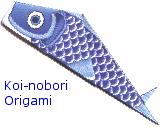

Tango-no-sekku
Boy's Day Celebration in Hawaii
Watching these colorful windsocks flapping in the wind reminds one of the vigor, strength and perseverance of the koi (carp) as they swim upstream against powerful currents. Koi are also known for their longevity. They can live for as long as 50 years in the wild and have been reported to live even longer in captivity. Thus the carp is a fitting symbol for the traits desired in sons.
Inside the house, families may display heirlooms such as swords, bows, arrows and special musha-ningyo, or Boy's Day dolls, mirroring the dolls displayed during the Girl's Day Festival. Common are elaborate dolls of warriors and legendary heroes of strength and valor, some posed on beautiful horses. The earliest samurai dolls date back to the Edo period, during the18th century, when displays were commissioned by those in the samurai class. Originally, only men could fashion these samurai dolls, and their doll-making secrets were passed down from generation to generation.
Boy's Day evolved from the Shinto iris festival, Shobu-no-sekku. Shobu is the Japanese word for the iris, and it also means "striving for success." The long narrow leaves of the plant resemble swords, which boys would sometimes use to stage mock sword battles. The iris is also thought to have healing powers, and families would hang iris leaves on their houses to ward off evil spirits. Today iris leaves are still used in making kashiwa-mochi, a traditional Boy's Day rice cake.
On the Origami Page you can make an Origami Koi-Nobori and an Origami Iris in celebration of Boy's Day. For beautiful photos of koi-nobori banners, click here.
Writing a paper on Japan? Interested in Japanese holidays, food, and history? Visit Kids Web Japan.
Menu:
The Keiki Page / Coloring / Javascript Games / Origami / Puzzles To Print / Turtle Talk / Keiki Links / Hawaii Schools / Home
Copyright ©2000 Tammy Yee. Paintings by Tammy Yee. All rights reserved.